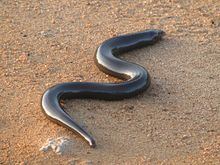Kingdom Animalia Subphylum Vertebrata Order Squamata Scientific name Typhlops bibronii | Phylum Chordata Class Reptilia Suborder Serpentes Rank Species | |
 | ||
People also search for Afrotyphlops, Typhlops fornasinii | ||
Typhlops bibronii, commonly known as Bibron's blind snake, is a species of snake in the Typhlopidae family. It is endemic to southern Africa.
Contents
Etymology
The specific name, bibronii, is in honor of French herpetologist Gabriel Bibron.
Geographic range
It is found in Botswana, Republic of South Africa, Swaziland, and Zimbabwe.
Description
This heavy-bodied species of blind snake is dark olive-brown to brown dorsally, and is paler ventrally. Adults are darker than juveniles. Adults may attain a snout-vent length (SVL) of 29.5 cm (11 5⁄8 in). Its scales are arranged in 30 rows around the body, and there are more than 300 scales in the middorsal row.
Snout very prominent, with an angular but not sharp edge, below which are located the nostrils. Rostral very large, extending posteriorly as far as the eyes. Portion of the rostral visible from above broader than long. Nasals semidivided, the suture proceeding from the first upper labial. Preocular present, narrower than the nasal or the ocular, in contact with the second upper labial. Four upper labials. Eyes distinct, below the suture between the ocular and the preocular. Prefrontal much larger than the supraoculars and the parietals, which are larger than the body scales. Diameter of body 28 to 36 times in the total length. Tail short, as broad as long, or broader than long, ending in a spine.
Habitat
Typhlops bibronii prefers coastal grasslands and the Highveld.
Behavior
Bibron's blind snakes are fossorial, and will burrow into brood chambers of termites and ants. They are protected from the bites of soldier ants by their close-fitting, shiny scales.
Diet
They feed on larvae and eggs of termites and ants.
Reproduction
Mature females lay eggs from January through March, which is late Summer in southern Africa. Clutch size varies from 5 to 14. Each egg measures about 43 x 10 mm (1⅝ x ⅜ inches). The embryos within the eggs are well-developed, and the shell walls are thin. The female may remain with the eggs, guarding them until hatching. After only 5–6 days, the newborns emerge, with an average total length (including tail) of 11.5 cm (4 1⁄2 in).
